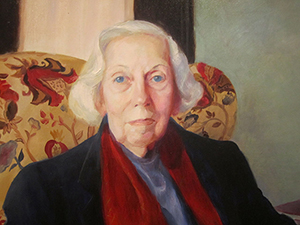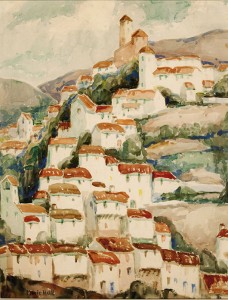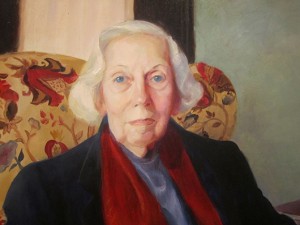JACKSON, Miss. (AP) – Three major artists in the literary and visual arts – author and photographer Eudora Welty, poet, novelist and scholar Margaret Walker and artist Marie Hull – are in the spotlight this year, with major events and exhibitions to propel fresh perspectives and new eyes on their works and legacies.Welty (1909-2001) and Walker (1915-1998) were close in age, while Hull (1890-1980) was just barely a generation older. Jackson native Welty spent her life here, while Alabama-born Walker moved here in 1949 to join Jackson State’s faculty (by then using her married name, Alexander). Marie Atkinson, born in Summit, came to Jackson for Belhaven College and made her home here, marrying Jackson architect Emmett Hull.
This year will see the yearlong Margaret Walker Centennial anchored at Jackson State University, the 12-week Welty Biennial starting in April at the Mississippi Museum of Art and nearby venues, and “Bright Fields: The Mastery of Marie Hull,” Sept. 26 to Jan. 3 at the art museum.
A new book, Meanwhile There Are Letters: The Correspondence of Eudora Welty and Ross Macdonald, by Welty scholar Suzanne Marrs is due out in July.
Belhaven University has named a Marie Hull Society for the Arts after its famed alumna – a cultural project to support fine arts programs, including a retrospective exhibition of Hull’s art – with different works – in summer 2016, and accompanying catalog/book.
“This Is My Century: 2015 Margaret Walker Centennial” marks what would have been Walker’s 100th birthday. Walker used Alexander as a professor of English at Jackson State for 30 years, but used her maiden name for her poetry, novel and essays.
“We’re trying to lift her into the national consciousness,” said Robert Luckett, director of the Margaret Walker Center. “In Mississippi’s great literary tradition, she seems to be the one who’s always kind of left out when we talk about Faulkner and Tennessee Williams and Eudora Welty and Richard Wright and all these other great writers, past and present.”
Centennial events continue with the Oxford Conference for the Book in late March, a Creative Arts Festival with a keynote by poet Nikky Finney and dedication of a Toni Morrison Bench by the Road, the “Mississippi Jubilee: From Slavery to Freedom” symposium, plus a photography exhibition by Doris Derby, all in April. It culminates in July with a Jubilee Picnic and a world-class gala with a new musical work by New York composer and pianist Randy Klein, For My People, as its centerpiece – Walker’s poetry put to music for piano, a vocalist and a chorale.
Walker was 16 when her first poem, I Want to Write, was published in the NAACP’s magazine The Crisis.
“From that point on, she found herself immersed in the 20th century black arts movement,” Luckett said. “She knew everybody,” from her close relationship with mentor Richard Wright at the Southside Writers Group in Chicago (after graduation from Northwestern University) to her roommate at the University of Iowa, artist Elizabeth Catlett.
Her master’s thesis in the famed University of Iowa’s Writers’ Workshop was her celebrated poem For My People. Fame found her when, in 1942, it won the major national Yale Series of Younger Poets prize, awarded to a black woman for the first time. She was 27.
She met Firnist Alexander while teaching in North Carolina, married and by 1949, the family moved to Jackson for her job in Jackson State’s English department. Those choices, as well as time and place, factor into her lack of greater acclaim, Luckett said.
While at Jackson State, Walker returned to Iowa to finish her doctorate and her dissertation was her greatest novel, Jubilee, published in 1966.
Works by Welty and Hull put an artist’s eye on Mississippi’s racial divide.
Medgar Evers’ assassination fueled the only work Welty wrote in anger, Where Is the Voice Coming From? a powerful piece written from the assassin’s perspective to reveal the nature of the murderer that appeared in The New Yorker in 1963.
It also marks the first literary intersection of Welty and Walker, whose later poem Micah in honor of Evers was among her poems equating civil rights leaders and martyrs with biblical prophets in Prophets for a New Day, said writer and scholar Carolyn J. Brown, author of biographies on Welty and Walker.
Hull’s 1936 painting of an African-American man who’d been born into slavery is direct, honest and titled An American Citizen and subtitled with his full name, Portrait of John Wesley Washington At Age 94. Bruce Levingston, curator of the Mississippi Museum of Art’s Hull exhibition this fall, said, “In a quiet, profound way, she was making a statement … restoring dignity to a man who deserved it all along.”
The Welty Biennial, starting April 10, is a fine arts festival that stretches across multiple disciplines as it celebrates Welty as a visionary American – author, photographer, witness and reporter of Mississippi to the world. Its theme of “Classical Mississippi” pegs the classical Greek heritage, from the architecture around her hometown to the constellations in the sky that fired her imagination.
Events involve Davis Planetarium, New Stage Theatre, the Mississippi Symphony Orchestra and Millsaps College, and the Mississippi Museum of Art. Eudora Welty House and schoolchildren citywide are on the calendar, as well as Oscar winner Olympia Dukakis in an adaptation of Welty’s short story Asphodel.
Brown found many similarities between Welty’s and Walker’s lives and careers in her research.
Both were born into families with a high priority on education, were early readers and won early recognition for their writings.
“Both credit moving away from the South for helping them develop as writers,” Brown said.
Walker’s race made it harder for her to get published, and money was a key motivator that drove her to positions that had the best salary.
“She didn’t have financial security until the Jackson State job,” Brown said.
Welty had connections, too, with Hull, who lived nearby in the Belhaven neighborhood.
“The story goes that Marie Hull helped Eudora and her mother design the walkway that leads up to the Welty House,” said Mary Alice Welty White, the author’s niece.
As a young girl, Welty took painting lessons from Hull.
Hull’s husband, prominent architect Emmett Hull, was supportive. They stood up, particularly during the WPA, for opportunities for Mississippi artists. After he died in 1957, her creativity exploded in the 1960s, a “fantastic final burst … in which she painted some of her greatest paintings, including the beautiful Bright Fields and Pink Lady and Ruins, “an abstract painting in Levingston’s collection thought to be influenced by the Ruins of Windsor and Welty’s photograph of it.
In researching Hull, Levingston was struck by “her absolutely indomitable determination to become an independent, working artist.”
“This was not a hobby for her. This was not just a career, but this was a way of life. It was the way she looked at things. She remains one of the greatest artists this state has ever produced; one of the country’s most important voices in regionalist painting,” he said.
___
Information from: The Clarion-Ledger, http://www.clarionledger.com
Copyright 2015 Associated Press. All rights reserved. This material may not be published, broadcast, rewritten, or redistributed.
AP-WF-03-24-15 1257GMT





